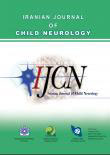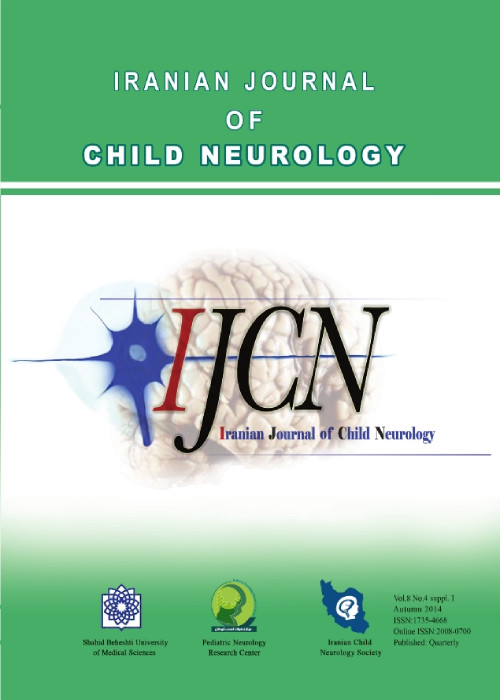فهرست مطالب

Iranian Journal of Child Neurology (IJCN)
Volume:11 Issue: 2, Spring 2017
- تاریخ انتشار: 1396/01/21
- تعداد عناوین: 11
-
-
Page 1Objective Herpes Simplex virus (HSV) is one of the most common sexually transmitted diseases in the world. This study aimed to determine the prevalence of herpes simplex virus in pregnant women in Iran.
Materials & Methods A systematic literature review was conducted to study the HSV subtypes in Persian and English papers through several databases. We searched Pub Med, Scopus, Ovid, Science Direct and national databases as Magiran, Iranmedex and Science Information Database (SID) up to October 2015. Random-effects model were applied to calculate the pooled prevalence of HSV subtypes.
Results Five eligible studies were identified, including 1140 participants. The pooled prevalence of HSV infection in pregnant women was 0.64% (95% CI: 0.101.18) in Iran. The pooled prevalence of studies on both HSV-1 and HSV-2 was 0.91% (CI: 0.81-1.02) and studies on only HSV-2 was 0.23% (CI: -0.61-0.63), respectively.
Conclusion The prevalence of HSV infection in pregnant women in Iran was higher. HSV infection of the central nervous system, especially with HSV-2, can also cause recurrent aseptic meningitis and monophasic, as well as radiuculitis or myelitis. The performance of screening to detect infection in pregnant women can play an important role in the prevention and treatment of patients and help to prevent the transmission of HSV infection to infants in Iran.Keywords: Herpes simplex virus, Pregnancy, Meta, analysis, Iran -
Page 8ObjectiveInfantile spasms is diagnosed late even by expert pediatricians. Late diagnosis (later than 3 weeks) can have a negative effect on the long-term prognosis. We aimed to investigate infantile spasms treated with intravenous methylprednisolone pulse.Materials and MethodsIn this case series study, 20 infants with infantile spasms in 17-Shahrivar Hospital, Rasht, Iran were enrolled. Drugs were administered based on Mytinger protocol that included 3 days of methylprednisolone pulse and 56 days of oral prednisolone. The control of spasms and the omission of hypsarrhythmia in infants followup were the primary and secondary outcomes, respectively. Remission was indicated if the caregivers mentioned no spasms or >50% decrease regarding drug initiation for at least 5 consecutive days and the electroencephalography during sleep period noted the omission of hypsarrhythmia.ResultsEleven female (55%) and 9 male (45%) patients with the mean age of 4.95±1.39 months were enrolled. Mean rapid remission was noted as 4.41±1.50 days. Twelve patients (60%) noted early remission. seizure was controlled in 3(15%) patients completely after 24 months. Five (25%) occasional seizures were noted controlled by routine anticonvulsant drugs after 24 months and 12 (60%) no response was mentioned. Most of the patients (65%) had cryptogenic etiology for infantile spasms. Uncontrolled seizure was mentioned after initial remission.ConclusionMethyl prednisolone is an appropriate drug based on easy administering, low cost, and its accessibility.Keywords: Infantile spasms, Prednisolone, Administration, Intravenous
-
Page 13Objective There have been contradictory findings on the relationship between Socioeconomic Status (SES) and child development although SES is associated with child development outcomes. The present study intended to define the relationship between SES and child development in Tehran kindergartens, Iran.
Materials & Methods This cross-sectional survey studied 1036 children aged 36-60 month, in different kindergartens in Tehran City, Iran, in 2014-2015. The principal factor analysis (PFA) model was employed to construct SES indices. The constructed SES variable was employed as an independent variable in logistic regression model to evaluate its role in developmental delay as a dependent variable.
Results The relationship between SES and developmental delay was significant at P=0.003. SES proved to have a significant (PConclusion There should be more emphasis on developmental monitoring and appropriate intervention programs for children to give them higher chance of having a more productive life.Keywords: Developmental delay, Child development, Principal factors analysis, Socioeconomic Status -
Page 26ObjectiveAnticonvulsant drugs can cause various forms of skin drug reactions, ranging from exanthema to severe blistering reactions. An association between HLA-B*1502 allele and severe skin reactions have been reported.Materials and MethodsFifteen patients with severe skin reactions following treatment with anticonvulsant drugs (Carbamazepine, lamotrigine, phenobarbital, primidone) and 15 controls (age-matched epileptic patients taking similar anticonvulsants without drug eruption) were included. They were referred to Mofid Childrens Hospital in Tehran, Iran, between Jan 2012 to Jan 2014. Genomic DNA was extracted from peripheral blood of all patients and HLA- B*1502 genotype was detected by real-time PCR.ResultsNone of the patients was positive for HLA- B*1502, but two patients in control group had positive HLA- B*1502.ConclusionThe HLA- B*1502 is not correlated with severe anticonvulsant drugs -induced skin reactions in Iranian children.Keywords: Drug eruption, HLA, B*1502, Anticonvulsants
-
Page 31ObjectiveIntractable epilepsy is a serious neurologic problem with different etiologies. Decreased levels of pyridoxal phosphate in cerebral spinal fluid of patients with intractable epilepsy due to pyridoxine dependency epilepsy are reported. The aim of this study was to compare plasma pyridoxal 5´-phosphate level in patients with intractable and controlled epilepsy.Materials and MethodsThis cross- sectional analytic study included 66 epileptic children, 33 patients with controlled and 33 patients with intractable epilepsy, after neonatal period up to 15 yr old of age. Thirty-three patients with intractable epilepsy (10162 months) and 33 patients with controlled epilepsy (14-173 months) were enrolled. The study was conducted in Pediatric Neurology Clinic of Mofid Children Hospital, Tehran, Iran from January 2010 to December 2010. Patients clinical manifestations, laboratory and neuroimaging findings were collected. Non-fasting plasma 5´- pyridoxal phosphate levels of these subjects were assessed by high-pressure liquid chromatography.ResultsMean plasma 5´- pyridoxal phosphate level (PLP) in patients with controlled epilepsy was 76.78±37.24 (nmol/l) (15.5-232.4). In patients with intractable epilepsy, mean plasma 5´- pyridoxal phosphate was 98.67± 80.58 (25.5393) nmol/l. There was no statistically significant difference between plasma pyridoxal phosphate levels of these two groups (P═0.430).ConclusionPyridoxine dependent epilepsy is under diagnosed because it is manifested by various types of seizures. Plasma pyridoxal phosphate levels did not differ in our patients with intractable or controlled epilepsy. If PDE is suspected on clinical basis, molecular investigation of ALDH7A1 mutations, as feasible test, until PDE biomarkers becomes available is recommended.Keywords: Pyridoxine Dependent Epilepsy, Intractable Epilepsy, Plasma Pyridoxal Phosphate Level, Children
-
Page 37Objective Overall, 2%-5% of patients with multiple sclerosis (MS) experienced the first episode of disease before the age 18 years old. Since the age of onset among children is not similar to that in general population, clinicians often fail to early diagnose the disease. This study aimed to determine the epidemiological and clinical patterns of MS among Iranian children.
Materials & Methods In this cross-sectional study carried out in Iran in 2014-2015, information was collected using a checklist with approved reliability and validity. Method sampling was consensus. Data were analyzed using frequency, mean and standard deviation indices by means of SPSS ver. 20 software.
Results Totally, 177 MS children were investigated. 75.7% of them were female. Mean (SD), minimum and maximum age of subjects were 15.9 (2), 7 and 18 yr, respectively. The most reported symptoms were sensory (28.2%), motor (29.4%), diplopia (20.3%) and visual (32.8%). Primary MRI results showed 91.5% and 53.1% periventricular and spinal cord lesions, respectively.
Conclusion MS is significantly more common among women. The most common age of onset is during the second decades. Sensory and motor problems are the most symptoms, while, periventricular and spinal cord lesions are the most MRI results.Keywords: Multiple sclerosis, Children, Epidemiology, Clinical, Iran -
Page 44Objective The aim of our study was to find the relationship of MPV (Mean Platelet Volume) levels and platelet counts as markers of inflammation between simple and complex febrile seizures.
Materials & Methods In this retrospective comparative study, we investigated the recordings of 356 children between 5 months and 6 yr with diagnosis of simple and complex febrile seizure (SFS&CFS) in Amircolas Childrens Hospital, Babol University of Medical Sciences, Babol, Iran between Mar 2011 and Dec 2015.
Results Mean age was similar in two groups. The MPV of the CFS group (8.32±0.48fl) was lower than that of the SFS group (8.58±0.34fl) but this difference was not significant statistically. The platelet count of the CFS group (315.03×103 ±117.17×103) was higher than that of SFS group (291.82×103 ± 87.49×103) but there was no significant statistical difference.
Conclusion We did not find significant differences between two groups. Therefore, further studies about this idea should be performed.Keywords: Febrile seizure, Convulsion, Mean platelet volume, Children -
Page 61One of the rare complications of brucellosis is neurobrucellosis. There have been numerous reports showing clinical forms of brucellosis affecting CNS, such as cranial nerve involvement, myelitis, vascular disease, radiculoneuritis, meningitis, meningoencephalitis, and demyelinating disease. In this case report, we introduce a 2.5 yr old girl with unilateral abducens nerve palsy referred to Baghiyatallah Hospital Outpatient Clinic, Tehran, Iran in June 2015.Keywords: Neurobrucellosis, Abducens nerve palsy, Neuroimaging
-
Page 65Moyamoya is a rare chronic progressive occlusive cerebrovascular disease. Its manifestation varies from stroke, progressive learning impairment and transient ischemic attack to headache and seizure. There is no accepted medical treatment and surgery usually, is needed. We report here a case of 8 yr old boy referred to psychiatrist outpatient. An eight yr old boy with intermittent hemiplegia was brought to Imam Ali Clinic, Yazd, Iran in 2015 because his headache and medical problem began from 6 yr old. Stress and excitement exacerbated his condition. His first attack was at the age of 6 yr old. During attack, he had incontinence, severe headache, alogia, pallor, claudication and left hemiplegia (Left lower limb). Magnetic resonance angiography (MRA) was done and our diagnosis was moyamoya disease. Moyamoya is a mysterious disease and psychiatrists should consider it in differential diagnosis of alogia and plegia. Acute management of this disease is mainly symptomatic. Nowadays, surgery is a good choice and early diagnosis of this disease can change our patients life.Keywords: Headache, Seizure, Hemiplegia, Moyamoya Disease
-
Page 69A tumefactive lesion of central nervous system (CNS) is defined as a mass-like lesion with a size greater than 2 cm in brain detected by magnetic resonance imaging (MRI). Neuroimaging may help to distinguish the nature of a tumefactive lesion and therefore, can prevent an unnecessary brain biopsy. Here we emphasized on determining the nature of a CNS tumefactive lesions with the help of MRI and more explanations about demyelinating lesions with focus on Schilder and Balo diseases as two multiple sclerosis variants. We have reported here two boys of 10 and 8 years of age respectively of multiple sclerosis (MS) variants who presented with acute neurologic complications to our hospital as one of the two referral children hospital in Tehran, Iran. Tumefactive demyelinating lesions can be considered a separate entity that itself can contain Schilder disease, Balo disease, some cases of acute disseminated encephalomyelitis (ADEM) or classic MS. MRI can help to establish a diagnosis of a tumefactive lesion and to differentiate among different underlying etiologies.Keywords: Central Nervous System, Demyelination, Tumefactive Lesion, Multiple Sclerosis Variants, Schilder Disease, Balo Disease
-
Page 78Myelodysplasia includes a group of developmental anomalies resulting from defects that occur during neural tube closure. Urological morbidity in patients with myelodysplasia is significant and if not treated appropriately in a timely manner can potentially lead to progressive renal failure, requiring dialysis or transplantation. We report the case of a 13-year old girl with neurogenic bladder who presented chronic renal failure secondary to lipomyelomeningocele with retethering of cord. She was managed with urinary indwelling catheterization until optimization of renal function and then underwent detethering of cord with excision and repair of residual lipomeningomyelocele. Her renal parameters improved gradually over weeks and then were managed on self clean intermittent catheterization. The case emphasizes the need for considering retethering of spinal cord in children with myelodysplasia where symptoms of neurogenic bladder and recurrent urinary tract infections occur.Keywords: Neurogenic bladder, Lipomyelomeningocele, Chronic renal failure, Urinary tract infections, Clean intermittent catheterization, Myelodysplasia


